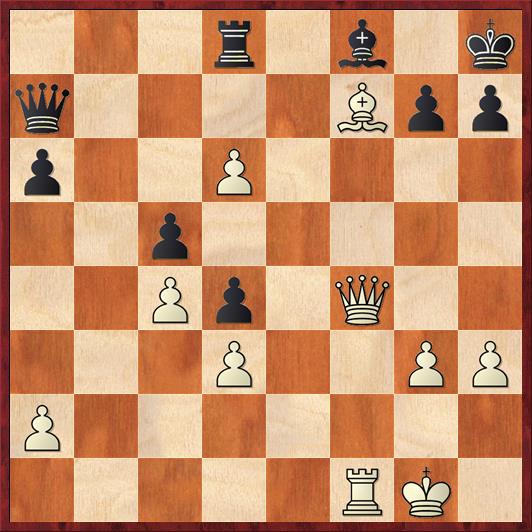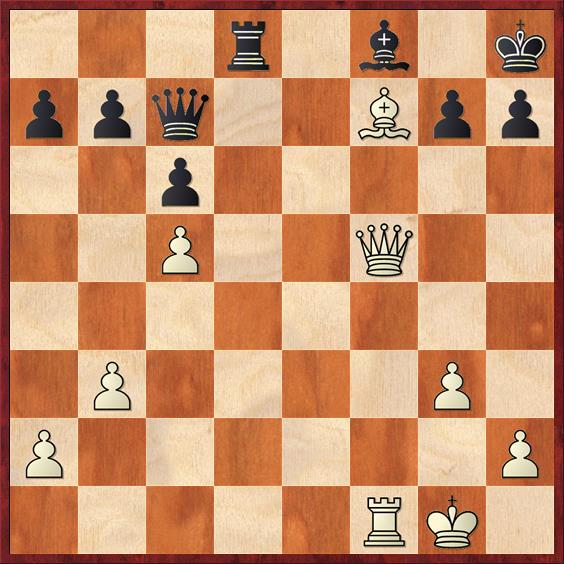One of my teammates at this year’s US Amateur Team tournament, Larry Smith, has an interesting semi-blog. It isn’t publicly accessible like a blog is, but he sends out chess-related e-mails a few times a week to a couple dozen people on his distribution list. The e-mails are usually of the “position of the day” variety but they sometimes go into a little bit more depth to explore a theme. He sent out a very interesting one earlier this month that I’d like to share with you.
 Position after 33. … Kh8. White to move.
Position after 33. … Kh8. White to move.
FEN: 3r1b1k/q4Bpp/p2P4/2p5/2Pp1Q2/3P2PP/P7/5RK1 w – – 0 34
This is a game between Bjarne Light and Peter Frost from this year’s Kiel tournament, played in July. Naturally, a lover of word play like me has to note the rarity of seeing Light-Frost in July.
Anyway, see if you can find White’s best move, and if you want to pay along with Larry Smith’s e-mail, take a note of how much time it takes you.
Some back story: Larry got this position from Susan Polgar’s blog, and she got it from a site of Alex Baburin called ChessToday.net. So you’re getting from me fourth-hand! The caption to the position on Baburin’s site is very telling: “Daily Chess Improvement: 8 Second Chess Tactic!” In other words, you’re supposed to solve it in 8 seconds or less.
I was able to spot the key move in easily less than 8 seconds: it was the first move I looked at. I spent a minute or so making sure that it really worked and that there wasn’t anything better, but if I had been down to a few seconds in a blitz game, there’s no question that I would have played the move in the game: 34. Be8!
It’s a neat idea. White puts both his bishop and pawn en prise, but whichever one Black takes, his back rank is too weakly defended and he loses to Q(x)f8+. Black could create luft for his king with 34. … h6, but he loses a piece right away to 35. Qxf8+ and it’s obvious that more losses are coming. In the game, Light simply resigned.
Larry had a very similar experience to mine. He wrote, “I didn’t so much solve the puzzle as the move 1. Be8! popped into my brain. It was a reflex that I had no control over.”
As he was puzzling over why this instantaneous flash of insight occurred, Larry realized he had seen the combination before! In fact, it occurred in the game Reti-Bogolyubov from New York 1924, one of the most famous tournaments ever.
 Position after 24. … Kh8. White to move.
Position after 24. … Kh8. White to move.
FEN: 3r1b1k/ppq2Bpp/2p5/2P2Q2/8/1P4P1/P6P/5RK1 w – – 0 25
The positions are so similar that it’s uncanny — only the positions of Black’s queen and a few pawns are different, and they do not affect the combination in any way. Now that you’ve seen the pattern, I’m sure you’ll have no trouble figuring out Reti’s move, 25. Be8! Once again, Black resigned immediately. The only complication that wasn’t present in the earlier game is that Black could try interpolating 25. … Bxc5+ 26. Qxc5 Rxe8. However, whether by luck or design, the White queen is still attacking f8, so 27. Rf8+ (or 27. Qf8+ if you want to be flashy) leads to a back-rank mate.
So now Larry was wondering: Did he solve the Light-Frost position so quickly because it had been implanted in his brain already? If he were truly seeing it for the first time, would he be able to come up with the answer so fast?
That’s when he decided to do an experiment with his e-mail discussion list. He asked his friends whether they had found the key move, how long it took, and whether the position looked “familiar.” Four out of 11 said that it “looked familiar” (two knew the exact game Reti-Bogoljubov) and of those, three solved it in under 5 seconds and the other solved it in under a minute.
As for the other seven, who did not recognize the position, six of them took significantly longer, from 1 to 10 minutes. So it seemed that recognizing the motif helped. The one person who did not recognize it but still solved in in 5 seconds… was me.
That complicates things a bit, because it introduces another factor — player strength. The four people who recognized the position were all over 2000. I’m also over 2000. So maybe you don’t need to know chess history. Maybe people over 2000 are just good enough at spotting mating patterns that they will solve a puzzle like this very quickly. Speaking for myself, it was as easy as 1-2-3. (1) I want to open the f-file. (2) I want to set up a back-rank mate, and cutting Black’s rook off from the defense of the bishop would help. (3) Be8 does both things.
So in the end, Larry’s experiment didn’t have a definite conclusion. Maybe the moral is that studying the classics can teach you to recognize important patterns, but also hours of practice and years of exposure to chess ideas can accomplish the same thing. I do feel a trifle embarrassed that I don’t know my chess history as well as the four who recognized the idea; on the other hand, I feel a little bit pleased that, alone out of Larry’s 11 respondents, I solved the puzzle immediately without having seen the idea before.
By the way, one thing that impressed me as I played out the games (not just looking at the static positions) was that both Reti and Light saw the combination coming. Both of them played Bf7+ on the previous move to chase Black’s king to the corner and set up the back-rank mate.
Unrelated postscript: One of my readers informed me that the link to the “Bird by Bird” series on the right-hand side of my blog page is now broken. I’m not quite sure what is causing this issue. It’s stored on a part of my website that I thought would be more stable than the blog, so it’s a shock to see it disappear all of a sudden. Probably I should take this as a warning that I need to update and upgrade my blog site, too.
This is something that annoys me about computers. I feel as if they should be designed like most other appliances, in such a way that once they are working, they should continue working unless they literally break. But with computers, the outside world is constantly changing and so the interface between the computer and the outside world changes, and sometimes software that worked perfectly well one day no longer works the next. Argh!



{ 5 comments… read them below or add one }
I can’t help thinking that black must have blundered to allow this position to develop. When white doubled its Q and R on the same file then surely black should have seen the threat immediately. I solved this in a few seconds and I’m only a 1750 player.
I like giving various motifs unique names, a la Dana’s “hook and ladder” so I’d call whites bishop move “block the back door” or perhaps a “suicide screen”. Pushing the enemy king “into the tunnel” is done by “blowing the king back”.
My rating is over 2000.
I solved it immediately, maybe because I’ve seen the Reti Bogolyubov game at least three separate times. My first impression was the diagram showed the position from that game, but I quickly, within 4-5 seconds, recognized that it was a different one.
I’ve solved all of the positions in Reinfeld’s book, “1001 Brilliant Ways to Checkmate” at least ten times, so these type of checkmating themes always jump right out at me. IIRC the R-B position is a puzzle in that book.
Dana,
Thanks for liking my little experiment enough to write about it in your blog. As usual, you did a great job in setting the table and explaining my results, such as they were. Like many such experiments, though, it probably raises as many questions as it answers.
Although it’s now been over a month since I first saw this position, my recollection is my reaction was more like Mike Splane’s: namely, I think I flashed immediately on the Reti-Bogoljubov game, and like Mike possibly thought “what’s that position doing here?”
However, the reactions of those other players I surveyed to whom the position looked familiar were more along the lines of “gee, this looks familiar to me, and I think Be8! is the right move.” In either case, though, I strongly suspect knowing this pattern decreases the solution time tremendously, though we also know that strong players without explicit knowledge of the Reti game are also capable of finding the key move quickly.
Re: Paul B’s comment that it looks like Black basically blundered to allow this to happen: I know that in the Reti game it was not so much that Bogo blundered, but was thoroughly outplayed and with little hope of surviving embarked upon a path from which there was no turning back.
It appears to me that something similar happened in the Light-Frost game, where White had a dominating position and Black seemed to have no way out. This game can be found at https://www.chess.com/forum/view/game-showcase/imitation-of-reti-vs-bogoljubov-1924. You can see from the URL that I am not the only one to have seen the amazing similarity between the two games!
Another site that has also caught wind of this game and its similarity to Reti and other games (though none quite as strikingly) is at https://www.chess.com/article/view/the-sparkling-bishop-combo?page=2.
Finally, I think it would be interesting to know if Light realized during the game that he was on the verge of duplicating Reti’s famous combo, or if he “invented” the same idea on his own.
On Chess.com there was an article a few weeks ago about this same subject see https://www.chess.com/article/view/the-sparkling-bishop-combo
Obviously after having read the chess.com article very recently it didn’t take 1 second to solve your problem.
I think as far as in the 1920-s Alekhine wrote an article “On continuity of chess combinations.” It’s mentioned in the Kotov’s 2-volume monography on Alekhine, I’ll try to find the relevant excerpts.